RObERt HuGHeS: A MoDerNist FaScinAtIOn
by Alex Walsh

Photo by Walter Baumann
Bob Hughes is a bassoonist, composer, conductor, and scholar. Over the years he performed in all the Civic Center orchestras (particularly the opera and ballet),was a tenured player in the Oakland Symphony/East Bay Symphony for nearly 40 years and played in the Freeway Philharmonic for the same period. He has performed and conducted in Europe and Japan as well as throughout the United States. For this interview, I met with Bob and his wife Margaret Fisher at their home in Emeryville. Betsy London worked with Bob in the Oakland Youth Orchestra and Arch Ensemble and joined us for the conversation.
Bob retired from performing in 2003 and sold both his bassoon and contra. I began the interchange by asking him why he stayed in the Union. “In the 1930s, my father was a Teamster who attended union organizational meetings, often to return home a bit ruffed up by scabs and employer thugs. It made me very aware of the avarice of Corporate America. Since then, I’ve learned to appreciate unionism as an important ally in collegial, pragmatic and fiscal matters.”
Born in Buffalo, NY in 1933, Bob joined Musicians’ Union Local #92 during his college years at the University of Buffalo. The Union paid him tribute; they inducted him into their affiliate, the Buffalo Music Hall of Fame in 2004. As a graduate student at the University, majoring in music and cultural history, Bob honed his conducting chops by preparing Buffalo Philharmonic musicians for lecture-demonstrations given by Visiting “Composer in Residence” Aaron Copland, followed by Carlos Chavez.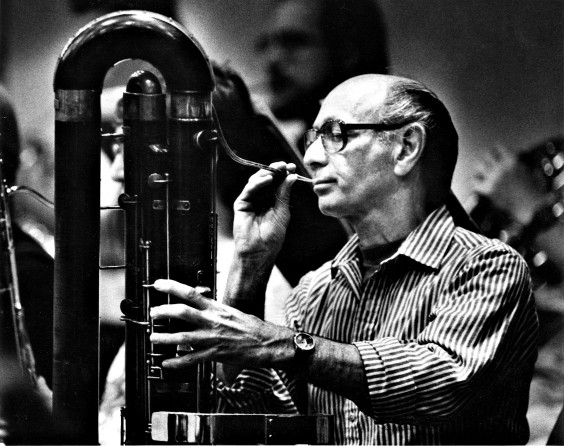
A unique memory from those years was an encounter with jazz saxophonist Gerry Mulligan at a local jazz club. During the break Bob asked Mulligan if he had ever improvised to a classical composition. Mulligan said he’d “give his eye teeth to improvise to Bach’s Brandenberg Concert #6.” The following Sunday Bob assembled a small ensemble from the Philharmonic. Mulligan improvised gloriously to the 2nd and 3rd movements, but discovered that Bach’s 1st movement chord changes were too quick to follow. An indelible memory!
In 1958 a Baird Foundation fellowship took him to Italy for two years where he studied composition with Luigi Dallapiccola, spent the summer at the International Course for Modern Music in Darmstadt, Germany and earned his Conducting Certificate at the Mozarteum in Salzburg, Austria (in the meanwhile gaining his ‘second language,’ Italian, which to this day he speaks on a daily basis with his wife Margaret “just to keep it fluid.”
After the two years abroad Bob had a desire to move on, using the last of his fellowship money to travel to the then small town of Aptos south of Santa Cruz to study intonation systems with a composer he greatly admired, Lou Harrison, thus beginning a participation in the ‘Pacific Rim’ aesthetic which included Steve Reich, Pauline Oliveros and Terry Riley. With Harrison, Bob established a concert series at the Sticky Wicket Restaurant and, two years later, the Cabrillo Music Festival. At that time, San Francisco was experiencing a shortage of bassoonists. Bob began receiving calls to play in SF. He joined Local #6 in 1962, moving to the Bay Area the following year. During his career as a bassoon/contra player from 1960 to 2003, Bob played with all of the major Bay Area orchestras.
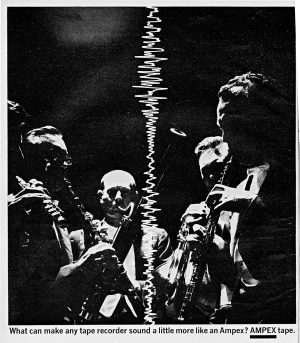
California Wind Quintet photo for a 1962 AMPEX tape Ad:
Leroy Subke, Flute, Donald Carroll, Clarinet, Bob Hughes, Bassoon,
Ross Taylor, French Horn, Ray Duste, Oboe.
In 1963 Bob was Assistant Conductor of The Oakland Symphony and conductor of its Youth Chamber Orchestra (YCO). That was before the San Francisco Symphony established its own youth orchestra. As a result Bob capitalized on the opportunity to utilize the brilliant young players, particularly string players, children of UC Berkeley faculty. Local 6 musician, Betsy London, an YCO alumnus, recalls this period: “We did tours, we did recordings, all sorts of wild and crazy things. Bob was our fearless leader. He was a role model for all of us. He showed us there were other things you could do in your life with classical music—not just play a Beethoven symphony 10 times. When he ran the YCO, we felt like Bob was God.”
During Bob’s tenure as conductor from 1963 to 1970, YCO premiered works by Laurie Anderson, Lou Harrison, Ned Rorem, Henry Brant and other living composers. YCO made extended multi-concert tours from Seattle to New Orleans; playing an all black repertoire on the latter tour. Their Gold Rush country tour included music composed in situ in 1849–50 and printed on early presses in San Francisco. For this tour Hughes extensively searched and unearthed (from an uncataloged storage warehouse of the Library of Congress, Washington, DC) Camille Saint-Saëns “Hail! California,” the only prior performance being at the San Francisco 1915 Panama Pacific Exposition with the composer conducting. In another quest Hughes located and premiered music composed by writer Robert Louis Stevenson on his flageolet during his stay in Monterey in 1879–81. From this rich repertoire the YCO under Hughes issued four commercial LPs on Desto Records.
Bob conducted the YCO for seven years, influencing a generation of musicians who are now performing in concert halls around the world, a number of them in the SF Symphony. “The tricky thing, back in the sixties,” recalls Bob, ”is that it was a very rebellious age. The last thing you could do to succeed was to be a square, or a tyrant on the podium. So you had to be as rough and tough as those kids were in private with each other. It is ironic that they were courteous to me most of the time, while I eventually got fired by the YCO Board because I used a lot of four-letter words.”
Bob was asked back a few years later after his successor Denis de Coteau had expanded the orchestra to full symphonic size. Bob accepted with one requirement: that the entire orchestra, nearly 100 musicians, tour Italy to perform the “Rite of Spring.” The orchestra performed “Rite” three times on their seven-concert Italian tour, as well as Mahler’s 10th Symphony, a commission by Olly Wilson and a suite of works composed by Bob.
In 1971 an important milestone occurred in Bob’s life when he conducted the premiere of the opera Le Testament (1923) by the controversial American poet Ezra Pound with the San Francisco Opera’s experimental wing, Western Opera Theater. The following year he recorded the opera at Fantasy Records in Berkeley thanks to a Ford Foundation grant. This important link connecting Bob with Ezra Pound as a composer of music became a salient part of Bob’s life and will be referred to again later in this interview.
In 1972 Bob founded (with baritone Thomas Buckner), and conducted the Arch Ensemble for experimental music, a chamber group of sixteen players with electronics. Many of the works they commissioned were recorded and released on the Arch label. The venture lasted into the early eighties. During this time Bob continued to play his vigorous bassoon schedule and compose new music.
During the mid-seventies, trouble was brewing in the concert halls. Traditional orchestra musicians began to protest the staging of experimental works in established venues. It was in this context that Bob met his future wife Margaret Fisher at the 1976 Cabrillo Music Festival where she was solo dancer in an experimental opera conducted by him. Bob explained that during the performance “two of the musicians from the orchestra ( both Local 6!) decided to add to the weirdness of the event so they ‘streaked’ down the two aisles of the theater in the nude!” This rather unique introduction led Margaret and Bob into a life together with many artistic collaborations. Their ‘performance art’ group Ma Fish Co performed throughout the US, including Alaska, Canada, Europe and Japan.
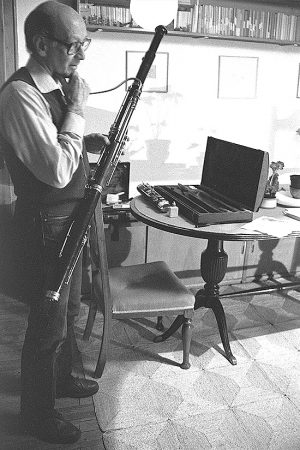
Bob with Ezra Pound’s bassoon at the poet’s
family castle in the South Tyrolean Alps.
In 1977 Bob was “Composer-in-Residence” of the San Francisco Symphony’s summer program. For the occasion he composed a Berlioz-size work for the Symphony with movements for student orchestra, band, chorus, an ensemble of flutes and harps, and a large brass group. Bob titled the work HCE (after James Joyce’s Finnegans Wake “Here Comes Everybody”), using those pitches, with the “H” sounding “B” as in the German solfeggio system.

Bob’s piano.
During the 1980s Bob continued to conduct, keeping up his full bassoon/contra schedule, but by the ‘90s he saw the need to end his triple ‘player-composer-conductor’ career. In 1992 Kent Nagano offered Bob the opportunity to conduct a series of all-Frank Zappa programs with the Lyon Ballet (France). Bob felt it would be a grand event with which to draw his conducting activities to an end. He put down the baton by the end of that year.
In 1983 Bob again became involved in his lifelong interest, the poetry and music of Ezra Pound. That interest was kindled when Bob earlier met and talked with Pound during his captivity in Washington DC’s St. Elizabeths “Nut house.” This was just before Pound’s release in 1958. Bob is one of a few persons still living who actually met Pound at that time. (Oddly enough, Pound’s two instruments were the clavichord and the bassoon!)
One of the last events the Arch Ensemble presented was an all-Pound music concert in Herbst Hall, San Francisco in March 1983. The highlight was the premiere of Pound’s second opera Cavalcanti (1933), conducted by Bob. The opera was long thought lost, but Bob located half of it in Venice, Italy, a happy consequence of his meeting with Pound’s mistress and music advisor, the concert violinist Olga Rudge, during the Youth Orchestra’s Venetian gig. He located the remainder of the music among the uncataloged Pound papers at Yale University. Olga Rudge was flown in to supervise and attend the concert. Gradually, over the years, Bob and Margaret got to know Pound’s whole family.
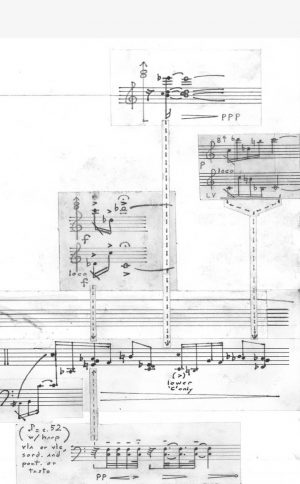
Detail from “Silenus’ Antiphonary”.
By then, Pound’s publisher New Directions had begun to press Bob and Margaret to write a book about Pound and his music. Margaret, obtaining her Ph.D. in the meantime, published Ezra Pound’s Radio Operas with MIT Press (2002), a study of the BBC’s 1931 experimental treatment and broadcast of Pound’s first opera Le Testament. From 2003 to 2011 their work was collaborative; they published their research in five scholarly volumes with engraved scores, facsimile scores, analysis and historical background to Pound’s entire musical œuvre (Second Evening Art Publishing, www.ezrapoundmusic.com) Their work took them frequently to Europe, including a year in Rome at the American Academy and research at the Vatican Library.
During the nineties, Bob continued to play bassoon and compose, but in 2002, at age 69, he decided to retire from the performing life. “I knew every contractor in the Bay Area; I think I played in every orchestra. I did it all at once, sending my resignation letters to all concerned on the same day.”
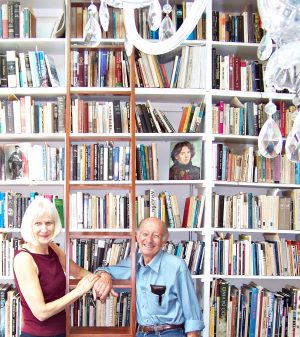
Margaret & Bob at home.
In retirement, Bob says he has a new appreciation for the Musicians Union. “My AFM pension, along with Social Security, have given me a very comfortable lifestyle. I recommend an expanded life in music to all musicians.”
In 2003 Bob also started work on a big composition, Silenus’ Antiphonary (a multi-perceptual work involving music, with interrelated words and graphics). “Due to my age, I decided to do exactly what I’ve wanted, without restrictions. Much of the time, my previous compositions were commissions, or requested by friends. I set out with no real idea where Silenus’ Antiphonary was going to go. I just started with an idea, and let the idea develop. Within six pages, I knew what I was doing, where I was going.” Bob says he’ll continue composing Silenus’s Antiphonary until they have to pry his colored pencils from his hands. . . .
